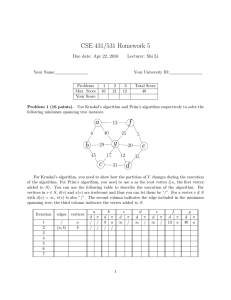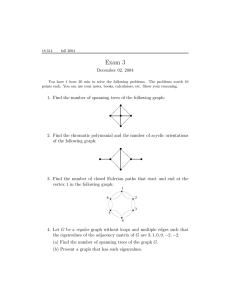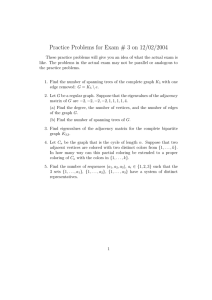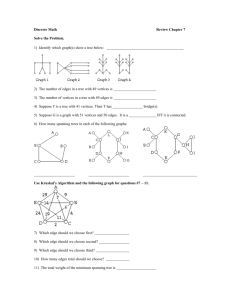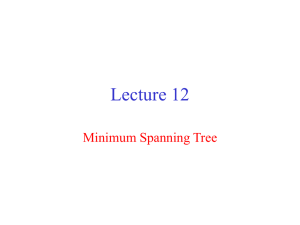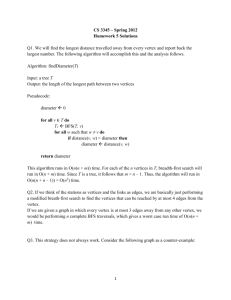Document 10677306
advertisement
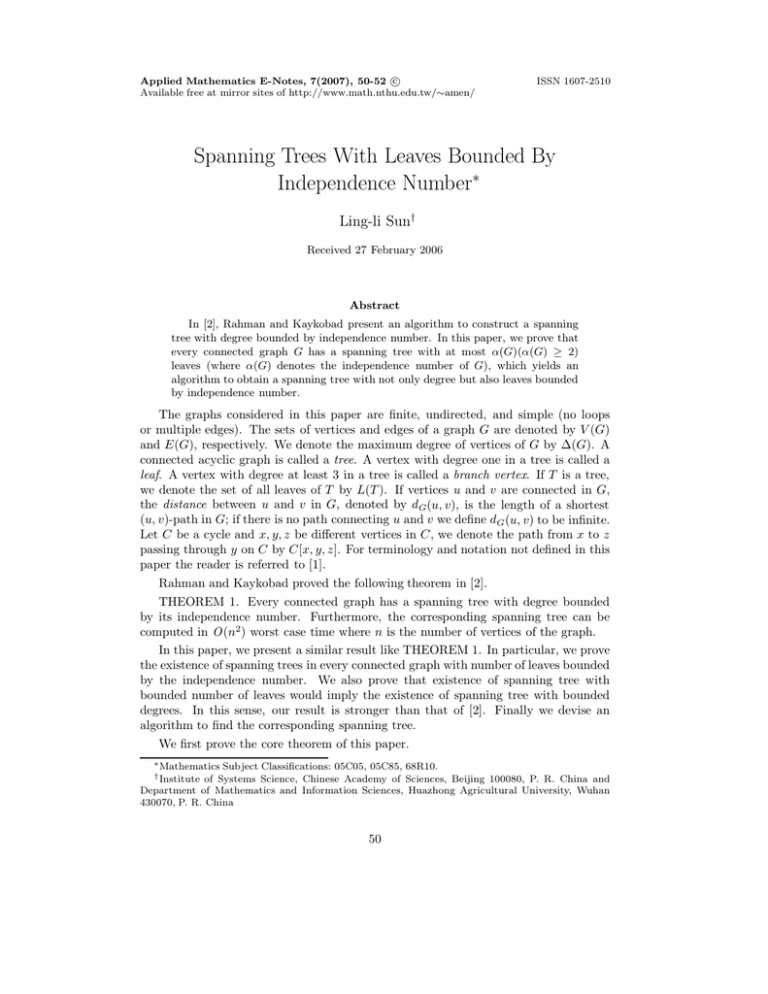
c
Applied Mathematics E-Notes, 7(2007), 50-52 Available free at mirror sites of http://www.math.nthu.edu.tw/∼amen/
ISSN 1607-2510
Spanning Trees With Leaves Bounded By
Independence Number∗
Ling-li Sun†
Received 27 February 2006
Abstract
In [2], Rahman and Kaykobad present an algorithm to construct a spanning
tree with degree bounded by independence number. In this paper, we prove that
every connected graph G has a spanning tree with at most α(G)(α(G) ≥ 2)
leaves (where α(G) denotes the independence number of G), which yields an
algorithm to obtain a spanning tree with not only degree but also leaves bounded
by independence number.
The graphs considered in this paper are finite, undirected, and simple (no loops
or multiple edges). The sets of vertices and edges of a graph G are denoted by V (G)
and E(G), respectively. We denote the maximum degree of vertices of G by ∆(G). A
connected acyclic graph is called a tree. A vertex with degree one in a tree is called a
leaf. A vertex with degree at least 3 in a tree is called a branch vertex. If T is a tree,
we denote the set of all leaves of T by L(T ). If vertices u and v are connected in G,
the distance between u and v in G, denoted by dG(u, v), is the length of a shortest
(u, v)-path in G; if there is no path connecting u and v we define dG (u, v) to be infinite.
Let C be a cycle and x, y, z be different vertices in C, we denote the path from x to z
passing through y on C by C[x, y, z]. For terminology and notation not defined in this
paper the reader is referred to [1].
Rahman and Kaykobad proved the following theorem in [2].
THEOREM 1. Every connected graph has a spanning tree with degree bounded
by its independence number. Furthermore, the corresponding spanning tree can be
computed in O(n2) worst case time where n is the number of vertices of the graph.
In this paper, we present a similar result like THEOREM 1. In particular, we prove
the existence of spanning trees in every connected graph with number of leaves bounded
by the independence number. We also prove that existence of spanning tree with
bounded number of leaves would imply the existence of spanning tree with bounded
degrees. In this sense, our result is stronger than that of [2]. Finally we devise an
algorithm to find the corresponding spanning tree.
We first prove the core theorem of this paper.
∗ Mathematics
Subject Classifications: 05C05, 05C85, 68R10.
of Systems Science, Chinese Academy of Sciences, Beijing 100080, P. R. China and
Department of Mathematics and Information Sciences, Huazhong Agricultural University, Wuhan
430070, P. R. China
† Institute
50
L. L. Sun
51
THEOREM 2. Every connected graph G has a spanning tree with at most α(G)
(α(G) ≥ 2) leaves.
PROOF. Let T be a spanning tree of G with fewest leaves. We may assume that T
has t leaves v1, v2 , . . ., vt (t ≥ 2). Since T is a spanning tree with fewest leaves, we have
that {v1 , v2, . . . , vt} is an independent set. Otherwise if there exists vi vj ∈ E(G)(1 ≤
i, j ≤ t), let ui be the branch vertex of T such that dT (ui , vi) is minimum, Pi be the path
from ui to vi in T and ei be the edge incident with ui in Pi , then T 0 = T + {vi vj } − ei
is a spanning tree with fewer leaves than T , contradiction. Therefore t ≤ α(G). This
completes the proof.
The following proposition is Exercise 2.1.6 in [1].
PROPOSITION 3. If G is a tree with maximum degree ∆(G), then G has at least
∆(G) vertices of degree one.
THEOREM 4. Every connected graph G has a spanning tree with both degree
and leaves bounded by α(G) (α(G) ≥ 2).
PROOF. By THEOREM 2, we have that G has a spanning tree T with at most
α(G)(α(G) ≥ 2) leaves, i.e., |L(T )| ≤ α(G). Furthermore, we have that ∆(T ) ≤
α(G). Otherwise if there exists a vertex v ∈ T such that dT (v) > α(G), then by
PROPOSITION 3, |L(T )| ≥ ∆(T ) ≥ dT (v) > α(G), contradiction. This completes the
proof.
By Theorem 2 and the proof of Theorem 4, we only need to find a spanning tree of G
with at most α(G) leaves. In this section we outline a simple algorithm for constructing
a spanning tree with at most d leaves from an input graph G with α(G) = d. We also
present a simple worst case analysis of the algorithm and compare our algorithm with
the algorithm in [2].
ALGORITHM.
// Input: A connected graph G = (V, E) with α(G) = d.
// Output: A spanning tree T with at most d leaves.
Begin
1. Construct an arbitrary spanning tree T of G.
2. Form the set L(T ).
3. if |L(T )| ≤ d, then
4. return T
5. else
6. while |L(T )| > d do
7.
Find a pair of vertices x, y ∈ L(T ) such that (x, y) ∈ E(G)
8.
Let C be the cycle yielded in T + (x, y) and (u, v) ∈ E(C[u, x, y])(where u is
the branch vertex of T such that dT (x, u) is minimum)
9.
T = T + (x, y) − (u, v)
10.
L(T ) = L(T ) − x − y + v
11. end while
12. end if
13. return T
End
52
Spanning Tress with Bounded Degree
ANALYSIS: Let |V | = n and |E| = m. Constructing an arbitrary spanning tree
takes O(m) computational effort. Forming the set L(T ) at most takes O(n). To find
out how many operations are actually done in the worst case in the while loop of line
#6 to line #11, we just need to realize that there can be O(n2 ) pairs of x, y to be
checked in line #7 in the worst case. So the overall running time is O(n2 ).
Our algorithm comparing with the algorithm in [2] reduces the steps forming the
set of vertices with dT (v) > d and finds a spanning tree with both degree and leaves
bounded by d. Thus we get the following theorem.
THEOREM 5. Given a connected graph G = (V, E) with α(G) = d(d ≥ 2), we can
find a spanning tree with both degree and leaves bounded by d in O(n2 ) computational
effort, where n = |V (G)|.
Acknowledgments. The author would like to thank the referees for their helpful
comments which improve the presentation of this paper.
References
[1] J. A. Bondy and U. S. R. Murty, Graph theory with Applications, The Macmillan
Press LTD, 1976.
[2] M. S. Rahman and M. Kaykobad, Independence number and degree bounded spanning tree, Applied Mathematics E-Notes, 4(2004), 122-124.
